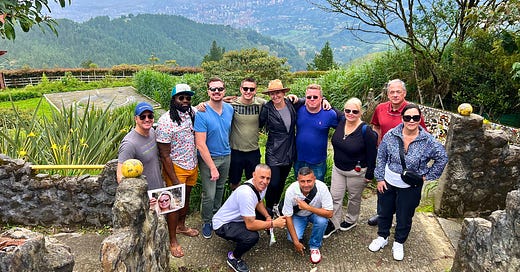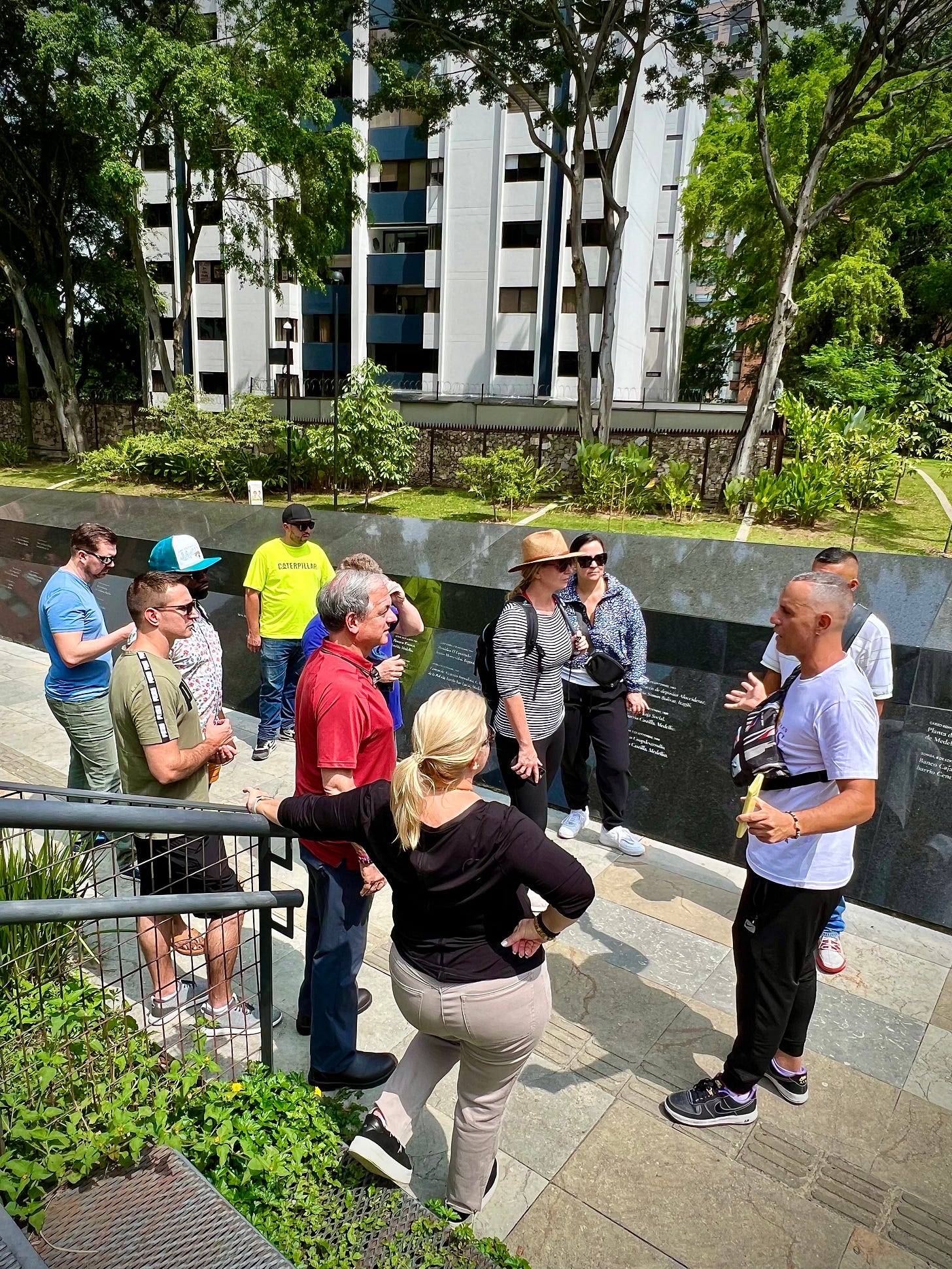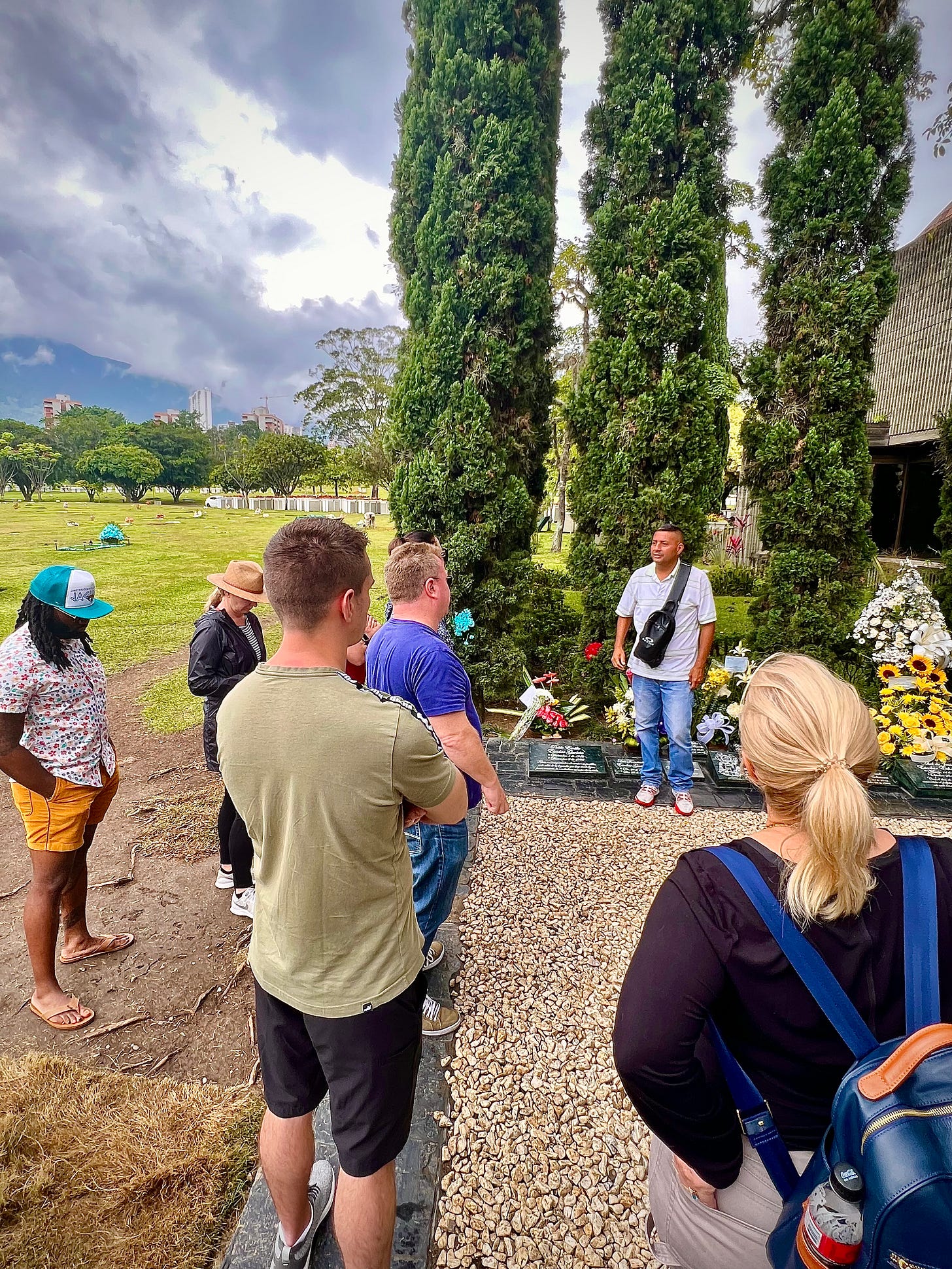The Pablo Escobar tour we did not expect
The people we met on our Fearless Journeys group trip to Medellin were not people our group ever expected they would get to meet and spend time with.
A few days ago, I gave you an overview of the recent Fearless Journeys group trip to Medellin, Colombia. Right at the top I mentioned that “when outsiders who have never been to Colombia first think about it, often drugs, crime, and Pablo Escobar come to mind.”
My very first personal trip to Colombia was earlier this year in March. Prior to coming, I asked a number of friends who had been there what they liked and what I should consider doing in Medellin.
One of my friends from Germany just happened to be visiting Florida a week or so before I went to Medellin. He had been there the year before. When I asked him: what was the best thing you did in Medellin, he replied: “The Pablo Escobar tour.”
“Really?” I thought? Even though I have watched the Netflix series Narcos, I was not really interested in going to Pablo Escobar sites. The guy was a mass murderer and has ruined the lives of millions of people. I was not interested. I was more interested in seeing the transformation of Comuna 13 and riding the metro cables. Plus: eating all that great food I’ve heard about. And doing so while spending pesos with my American dollars.
“Ganar en dólares, gastar en pesos.”
After a few days of working remotely from Medellin, I finally decided to search for a tour that might take me to some of these landmarks. I searched for “Comuna 13 and metro cables.” That’s when a combination tour emerged that would take me to those places plus give me the Pablo Escobar tour.
“Interesting,” I thought.
After opening my mind a bit, I went ahead and took the chance. I sent the tour company a message and they quickly arranged for me to do the full tour the next day. I was the only one on the tour with my private guide, Carlos. We spent about 8 hours together from 1:00 pm to 9:00 pm. He was very committed to showing me some special parts of Medellin.
Carlos picked me up at the apartment I had been renting through Airbnb in the El Poblado section of the city, where many tourists travel to and where many expats set themselves up in coworking spaces.
Carlos told me about his background. He’s 52 years old. He grew up in Medellin. When he was around 8 or 9 years old, his parents had him go to Los Angeles, because of how influential the cartels were in Medellin and because they were recruiting children as young as him. Other kids were simply getting recruited into gangs. Carlos’ parents had the foresight to get him out of there. Many other children weren’t so lucky.
Later Carlos would tell me that as a Colombian kid in Los Angeles in the 1980s, he was often alone and also discriminated against. Most Colombians migrate to the east coast of the U.S., so few people on the west coast ever encountered many Colombians at that time. His teachers and other adults who would encounter him would treat him as a potential threat. The only idea they had of Colombians were gangsters and drug traffickers. He sought to prove them otherwise and did his best to fit in with other kids.
It was only about 8 years ago that Carlos finally returned to Medellin — to live. While he was a proud American, a U.S. citizen, he was really interested in learning more about the country from which he was born. However, when he first returned to Colombia, his Spanish wasn’t very good. He has had to re-learn it.
Carlos had been involved in doing some educational tours in Southern California, so he picked up that same type of job in Medellin, where he takes people to various sites related to Pablo Escobar, but also to do things like ride the Metro Cables and see the transformation of Comuna 13. He really showed me another side of Colombia. And I believe he just did the same thing for our group on the Fearless Journeys group trip to Medellin on October 25-29, 2023.
Carlos’ “special sauce” is not just taking you to these landmarks but also introducing you to local people. That’s what I really love about him because it is something similar to what I try to do with Fearless Journeys. Except for me: I have to go to places and build relationships with locals. Carlos helped me to that in one day.
On my visit in March, Carlos brought me to a site where a famous condo building once owned by Pablo Escobar once sat. After Narcos came out on Netflix, it started attracting the wrong kind of narco-tourism. The government had the building torn down only a few years ago and they replaced it with a memorial to the victims. And that’s what he showed me. We later brought our group trip here as well.
Some estimate Escobar’s victims were around 10,000 or 40,000. Others put the numbers around a half million. He certainly had hundreds of police officers and hundreds of elected and appointed officials in the Colombian government killed in his quest for money and power. We learned that here.
In one attempt to assassinate Colombia’s president, he bombed an Avianca Airlines plane, on November 27, 1989, killing all 107 people aboard and causing the destruction of the plane. A few years earlier, he had bombed the U.S. embassy in Bogota. These actions got the U.S. involved in wanting to bring Escobar to justice - no matter what alliances they had to make.
Escobar also mocked the U.S. by taking video of himself dressed up like a Russian, in the last days of the Cold War with the Soviet Union. In addition, he found a way to visit Washington D.C., under an alias, taking a photo with his son in front of the White House — while he was on the FBI’s Most Wanted List. This infuriated the U.S. government even more.
Carlos also took me to the “prison” that the Colombian government allowed Escobar to build for himself. It is an elaborate place on a mountain that the local living nearby referred to as “La Catedral.” It has one road in and one road out. Escobar paid the local people who lived along that mountainside road to alert him if any government officials were making their way up the mountain.
The place also has one of the most spectacular views of Medellin. As Carlos was showing me this view, that’s when I saw it.
“Is that a helipad?” I asked. Indeed it was.
What kind of prison has a helipad? It’s not clear if Escobar actually came and went from his “prison,” by helicopter, but we do know that plenty of other people did. Escobar brought prostitutes in. He also had some of his enemies and adversaries taken there, where he would torture and kill them during his 18 months at the “prison.”
Once he killed the Galleano brothers — former allies turned adversaries — and killed them in brutal fashion, the Colombian government (and presumably, the U.S. government) had enough. They moved in on the prison one night. That’s when Escobar and one of his buddies fled, by foot.
During our tour of the grounds (one I would later take our group trip to), we walked the same path that Escobar fled. A few hundred yards down the path, we got to a quiet stream of water, with a small little waterfall. Above it is a statue of the Virgin Mary. That statue had been on this path the day that Escobar fled.
I remarked to Carlos, “I guess Pablo had one last chance to turn to her and her son, but decided to go another way.”
That way would later lead to his own death. On my visit in March, we went to the site in which he was captured and killed (some who know him said he killed himself because he didn’t want to die in an American prison, but rather on Colombian soil). I’m sure pride had something to do with it too.
During that visit in March — and during our group trip in October — we also went to the gravesite and visited the Colombian soil under which Pablo Escobar is now buried and has been since he died in 1993. It’s one of the most visited gravesites in the world. Some come here to pay their respects (he’s a hero to some — including cocaine addicts). But perhaps many others, like myself, came here to see perhaps a piece of Colombian history that the people here are still trying to bury and move on from.
Escobar died in 1993. The Colombian government, the DEA, and CIA got so desperate to bring him to justice that they cut a deal with his rivals. If they helped them bring Escobar to justice, they would look the other way for a while. This allowed a new, more violent period of Colombian history to unfold over the next decade, which led to the area of Comuna 13 of Medellin to become one of the most dangerous parts of the world. Today, that area is peaceful and one of the coolest places I’ve ever been.
After charting the course through the Pablo Escobar tour and Comuna 13 with Carlos back in March, it led me to put together some great activities and experiences for our Fearless Journeys group trip that was held here last week, October 25-29.
I have many more details to share with you and I’ll do that in my next few posts. The stories I’m about to share with you get a lot more wild… just ask our group of travelers. Carlos and I provided them with some real surprises.
The people they met on this Fearless Journeys group trip were people they had no idea they were going to get to meet. I think they were terrified at first, but later they came to appreciate the opportunity they were given and perhaps the new mindset they have that go well behind Colombia.
One of the people we met and spent considerable time with over three days was a former hitman of Pablo Escobar… who was recruited by him at the age of 9.
Stay tuned…







